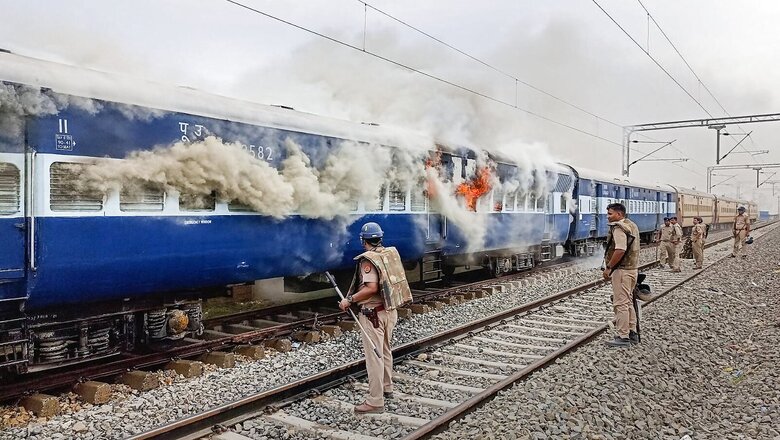
views
Since the unveiling of new Tour of Duty recruitment scheme ‘Agnipath’ on June 14, for the appointment of non-officer grade personnel in the armed forces, the scheme has not gone down well with the aspirants for the armed forces jobs, a few veterans, opposition leaders and policy makers.
The scheme was in the making for the past two years.
The consequent agitation against the new scheme has already resulted in humungous damage to the public property across the nation.
Such nonsensical destruction of the public property has no place in the civilised society and has to stop forthwith.
Wanton Destruction of Public Property
Where did the fire begin? Ara, my birthplace, in Bihar, on June 15. At some places, the agitation was impromptu while at others it was well orchestrated.
Who are the arsonists? A few of them definitely are the job seekers but many were miscreants, those at the fringe who are happy to be part of any agitation that involves the destruction of public property for private gain.
What strikes me most is the wanton willful destruction of the public property for private gain. I am neither for nor against Agnipath, but I am totally against the destruction of public property for any reason whatsoever it may be.
I believe in zero-tolerance against such a destruction.
It is premature to assess the collateral damage of the total debris of destruction so soon — it will need dust to settle down first — but it suffices to say at this stage the loss to the public property — railway, buses, office buildings, police vehicles — has been humungous. Early pointers are destruction of the public property worth thousands of crores in merely four days.
Such a mayhem has to stop.
I focus on the estimated losses to Indian Railways (IR), a sector with which I am more familiar with. In the late 1990s during the anti-Mandal commission reservation stir, while working as finance manager in Danapur division of railways in Bihar, the damage to the railway property was in excess of Rs 1,000 crore. And the damage to the railway property in four days of the anti-Agnipath stir has already exceeded this amount.
Bihar Again the Epicentre
Firstly, though the agitation has become an all-India phenomenon, the epicentre of the destruction of railway property has again been Bihar.
Two, the people of all ages have joined the holy task of the destruction — boys, men, old even girls, and women. And what they have not destroyed — torched railway stations, burnt and destroyed other immovable property including the track, burnt railway coaches, and in some cases, the whole train, in a manner that dwarfs the Burning Train, and worse, they have put on fire railway’s costliest resource — the locomotive
The Estimated Cost of Damage
It is early to estimate the total losses to Railways over the past four days, but there are early pointers. Before estimating the damage, it is instructive to first understand what the replacement cost is currently of railway moveable assets —
‘Rs. 75 lakh to 1 crore for one ordinary second class coach, Rs 1.25 crore to Rs 1.5 crore for second class sleeper coach, and Rs. 3.5 crore to 5 crore for one A/C Coach. A new locomotive cost anything between Rs 20 crore to Rs 25 crore. A twelve-coach train can cost around Rs 50 crore and a 24-coach train Rs 100 crore.’
Above numbers provide a reasonably good estimate of what it costs if a railway coach or a railway locomotive is destroyed, and this calculation does not take into account the lost earning capacity of the asset — how much a coach, or a locomotive would have earned in its lifetime.
The Divisional Railway Manager of Danapur has provided an initial estimate of the damage to railway property at Rs 200 crore. East Central Railway, to which Danapur division belongs, has now estimated the cost of destruction in the Zone in excess of Rs 700 crore. If we just add to it the matching destruction in South Central Railway, particularly the Secunderabad division, the number already totals up to Rs 1,000 crore.
Extrapolating the railway losses of Danapur Division, East Central Railway and South-Central Railway to pan-India level, one arrives at a number that should send shivers down the marrows.
Time to Stop This
A grievance of individual or collective, however justified, cannot override the national interest and cannot be made a ground for destruction of the public property. Unfortunately, destroying railways property got traction during the freedom struggle and further since the Independence. The uninitiated will be shocked to know that the present round of destruction of the Railway property is third in Bihar in this year — the first two were in January and May 2022.
Railway property has become the victim of public ire at the slightest of provocation.
Every destruction is worse than the other. Key reason why people are tempted again and again to damage more and more of railway property is the incapacity of Section 151 of Railway Act, 1989 to be a deterrent – it provides a maximum penalty of five years in jail.
It is time to bring suitable exemplary changes to the Railway Act and Indian Penal Code to introduce maximum penalty, that is, life imprisonment and nothing less for serious cases of damage of public property.
The trial has to be swift and summary and punishment exemplary, so no one again dares to play with fire and damage or destroy the public property however serious their grievances are.
Let time decide if the Agnipath scheme is good or bad. If proven bad, time will throw it out of the window. But whether it is good cannot be decided on the railway track, torching railway properties. The scheme once implemented can be chiseled, improved, and improvised.
Agnipath provides a pathway. If, on implementation, it is found that the scheme needs to be further tweaked, it will be, but first, it has to be given a decent trial.
Akhileshwar Sahay is a noted urban transport infrastructure expert and President, advisory services at BARSYL, a consulting firm. The views expressed in this article are those of the author and do not represent the stand of this publication or the company he works with.
Read all the Latest News , Breaking News , watch Top Videos and Live TV here.

















Comments
0 comment